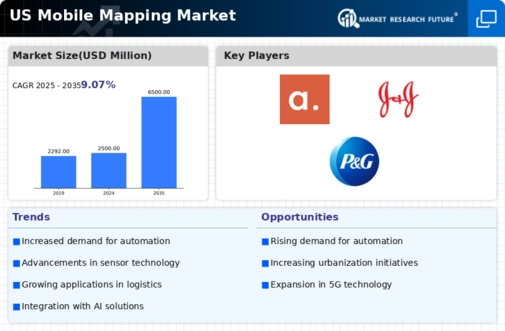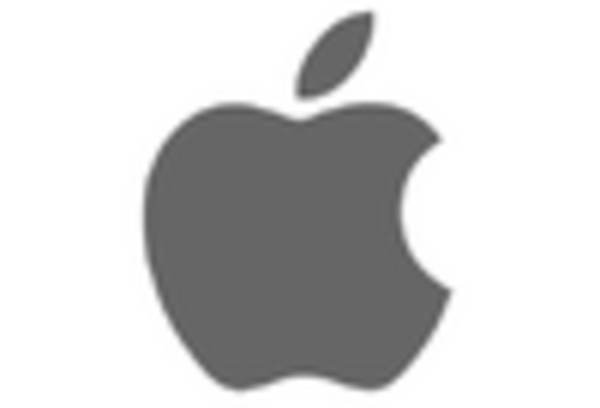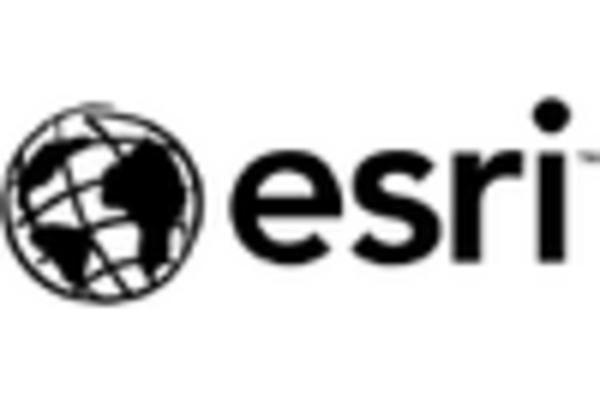Enhanced Safety and Compliance Regulations
The mobile mapping market is also influenced by enhanced safety and compliance regulations in various industries. As regulatory bodies impose stricter guidelines for data accuracy and safety standards, organizations are increasingly turning to mobile mapping solutions to ensure compliance. For example, the construction and transportation sectors are subject to rigorous safety regulations that necessitate precise mapping for risk assessment and management. The mobile mapping market is likely to see growth as companies invest in technologies that help them meet these regulatory requirements. This trend underscores the importance of mobile mapping solutions in facilitating compliance and enhancing operational safety.
Increased Investment in Smart Infrastructure
The mobile mapping market is benefiting from increased investment in smart infrastructure initiatives across the US. Governments and private entities are allocating substantial resources to develop smart cities, which rely on advanced mapping technologies for efficient management. The smart infrastructure market is expected to exceed $500 billion by 2027, highlighting the significant financial commitment to these projects. Mobile mapping solutions play a vital role in the development of smart infrastructure by providing accurate data for planning and monitoring. This trend suggests that the mobile mapping market will continue to thrive as stakeholders prioritize the integration of smart technologies into urban environments.
Technological Advancements in Mapping Solutions
The mobile mapping market is experiencing a surge due to rapid technological advancements in mapping solutions. Innovations in LiDAR, GPS, and imaging technologies are enhancing the accuracy and efficiency of data collection. For instance, the integration of high-resolution cameras and advanced sensors allows for the creation of detailed 3D maps. This is particularly relevant in sectors such as urban planning and infrastructure development, where precise mapping is crucial. The market is projected to grow at a CAGR of approximately 15% over the next five years, driven by these technological improvements. As organizations increasingly rely on accurate geospatial data, the demand for sophisticated mobile mapping solutions is likely to rise, further propelling the mobile mapping market forward.
Rising Urbanization and Infrastructure Development
The mobile mapping market is being propelled by the rising urbanization and infrastructure development across the US. As cities expand and infrastructure projects increase, the demand for accurate mapping solutions becomes critical. Urban planners and civil engineers require precise data to design and implement projects effectively. The US urban population is projected to reach 90% by 2050, necessitating advanced mapping technologies to manage urban growth. Mobile mapping solutions provide real-time data collection and analysis, which is essential for effective urban planning and management. This trend indicates a strong potential for growth within the mobile mapping market, as stakeholders seek to address the challenges posed by rapid urbanization.
Growing Demand for Geographic Information Systems (GIS)
The mobile mapping market is significantly influenced by the growing demand for Geographic Information Systems (GIS). As businesses and government agencies seek to leverage spatial data for decision-making, the need for mobile mapping solutions becomes more pronounced. The GIS market in the US is expected to reach $10 billion by 2026, indicating a robust growth trajectory. Mobile mapping technologies facilitate the collection and analysis of geographic data, enabling organizations to visualize and interpret spatial relationships effectively. This trend is particularly evident in sectors such as transportation, utilities, and environmental management, where accurate mapping is essential. Consequently, the mobile mapping market is poised to benefit from the increasing integration of GIS capabilities into mapping solutions.

















Leave a Comment